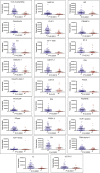Up-regulated proteins in the fluid bathing the tumour cell microenvironment as potential serological markers for early detection of cancer of the breast
- PMID: 20005186
- PMCID: PMC5527961
- DOI: 10.1016/j.molonc.2009.11.003
Up-regulated proteins in the fluid bathing the tumour cell microenvironment as potential serological markers for early detection of cancer of the breast
Abstract
Breast cancer is by far the most common diagnosed form of cancer and the leading cause of cancer death in women today. Clinically useful biomarkers for early detection of breast cancer could lead to a significant reduction in mortality. Here we describe a detailed analysis using gel-based proteomics in combination with mass spectrometry and immunohistochemistry (IHC) of the tumour interstitial fluids (TIF) and normal interstitial fluids (NIF) collected from 69 prospective breast cancer patients. The goal of this study was to identify abundant cancer up-regulated proteins that are externalised by cells in the tumour microenvironment of most if not all these lesions. To this end, we applied a phased biomarker discovery research strategy to the analysis of these samples rather than comparing all samples among each other, with inherent inter and intra-sample variability problems. To this end, we chose to use samples derived from a single tumour/benign tissue pair (patient 46, triple negative tumour), for which we had well-matched samples in terms of epithelial cell numbers, to generate the initial dataset. In this first phase we found 110 proteins that were up-regulated by a factor of 2 or more in the TIF, some of which were confirmed by IHC. In the second phase, we carried out a systematic computer assisted analysis of the 2D gels of the remaining 68 TIF samples in order to identify TIF 46 up-regulated proteins that were deregulated in 90% or more of all the available TIFs, thus representing common breast cancer markers. This second phase singled out a set of 26 breast cancer markers, most of which were also identified by a complementary analysis using LC-MS/MS. The expression of calreticulin, cellular retinoic acid-binding protein II, chloride intracellular channel protein 1, EF-1-beta, galectin 1, peroxiredoxin-2, platelet-derived endothelial cell growth factor, protein disulfide isomerase and ubiquitin carboxyl-terminal hydrolase 5 were further validated using a tissue microarray containing 70 malignant breast carcinomas of various grades of atypia. A significant number of these proteins have already been detected in the blood/plasma/secretome by others. The next steps, which include biomarker prioritization based on the hierarchal evaluation of these markers, antibody and antigen development, assay development, analytical validation, and preliminary testing in the blood of healthy and breast cancer patients, are discussed.
Figures









Similar articles
-
Proteomic characterization of the interstitial fluid perfusing the breast tumor microenvironment: a novel resource for biomarker and therapeutic target discovery.Mol Cell Proteomics. 2004 Apr;3(4):327-44. doi: 10.1074/mcp.M400009-MCP200. Epub 2004 Jan 30. Mol Cell Proteomics. 2004. PMID: 14754989
-
The cancer secretome, current status and opportunities in the lung, breast and colorectal cancer context.Biochim Biophys Acta. 2013 Nov;1834(11):2242-58. doi: 10.1016/j.bbapap.2013.01.029. Epub 2013 Jan 31. Biochim Biophys Acta. 2013. PMID: 23376433 Review.
-
Proteomic Profiling of Paired Interstitial Fluids Reveals Dysregulated Pathways and Salivary NID1 as a Biomarker of Oral Cavity Squamous Cell Carcinoma.Mol Cell Proteomics. 2019 Oct;18(10):1939-1949. doi: 10.1074/mcp.RA119.001654. Epub 2019 Jul 17. Mol Cell Proteomics. 2019. PMID: 31315917 Free PMC article.
-
High-throughput proteomics of breast cancer interstitial fluid: identification of tumor subtype-specific serologically relevant biomarkers.Mol Oncol. 2021 Feb;15(2):429-461. doi: 10.1002/1878-0261.12850. Epub 2021 Jan 4. Mol Oncol. 2021. PMID: 33176066 Free PMC article. Clinical Trial.
-
Resolving breast cancer heterogeneity by searching reliable protein cancer biomarkers in the breast fluid secretome.BMC Cancer. 2013 Jul 12;13:344. doi: 10.1186/1471-2407-13-344. BMC Cancer. 2013. PMID: 23849048 Free PMC article. Review.
Cited by
-
Restructuring proteomics through verification.Biomark Med. 2010 Dec;4(6):799-803. doi: 10.2217/bmm.10.92. Biomark Med. 2010. PMID: 21133699 Free PMC article. Review.
-
Immunoexpression analysis and prognostic value of BLCAP in breast cancer.PLoS One. 2012;7(9):e45967. doi: 10.1371/journal.pone.0045967. Epub 2012 Sep 25. PLoS One. 2012. PMID: 23049907 Free PMC article.
-
Multi-Segment Direct Inject nano-ESI-LTQ-FT-ICR-MS/MS For Protein Identification.Proteome Sci. 2011 Jul 7;9:38. doi: 10.1186/1477-5956-9-38. Proteome Sci. 2011. PMID: 21736728 Free PMC article.
-
Identification of proteins with different abundance associated with cell migration and proliferation in leiomyoma interstitial fluid by proteomics.Oncol Lett. 2017 May;13(5):3912-3920. doi: 10.3892/ol.2017.5943. Epub 2017 Mar 29. Oncol Lett. 2017. PMID: 28521489 Free PMC article.
-
Interstitial Fluid in Gynecologic Tumors and Its Possible Application in the Clinical Practice.Int J Mol Sci. 2018 Dec 12;19(12):4018. doi: 10.3390/ijms19124018. Int J Mol Sci. 2018. PMID: 30545144 Free PMC article. Review.
References
-
- Aebersold, R. , Mann, M. , 2003. Mass spectrometry-based proteomics. Nature. 422, 198–207. - PubMed
-
- Agha-Hosseini, F. , Mirzaii-Dizgah, I. , Rahimi, A. , 2009. Correlation of serum and salivary CA15-3 levels in patients with breast cancer. Med. Oral. Patol. Oral. Cir. Bucal. 14, e521–e524. - PubMed
-
- Anderson, N.L. , Polanski, M. , Pieper, R. , Gatlin, T. , Tirumalai, R.S. , Conrads, T.P. , Veenstra, T.D. , Adkins, J.N. , Pounds, J.G. , Fagan, R. , Lobley, A. , 2004. The human plasma proteome: a nonredundant list developed by combination of four separate sources. Mol. Cell. Proteomics. 3, 311–326. - PubMed
-
- Apweiler, R. , Aslanidis, C. , Deufel, T. , Gerstner, A. , Hansen, J. , Hochstrasser, D. , Kellner, R. , Kubicek, M. , Lottspeich, F. , Maser, E. , Mewes, H.W. , Meyer, H.E. , Müllner, S. , Mutter, W. , Neumaier, M. , Nollau, P. , Nothwang, H.G. , Ponten, F. , Radbruch, A. , Reinert, K. , Rothe, G. , Stockinger, H. , Tarnok, A. , Taussig, M.J. , Thiel, A. , Thiery, J. , Ueffing, M. , Valet, G. , Vandekerckhove, J. , Verhuven, W. , Wagener, C. , Wagner, O. , Schmitz, G. , 2009. Approaching clinical proteomics: current state and future fields of application in fluid proteomics. Clin. Chem. Lab. Med. 47, 724–744. - PubMed
Publication types
MeSH terms
Substances
LinkOut - more resources
Full Text Sources
Other Literature Sources
Medical
Research Materials

